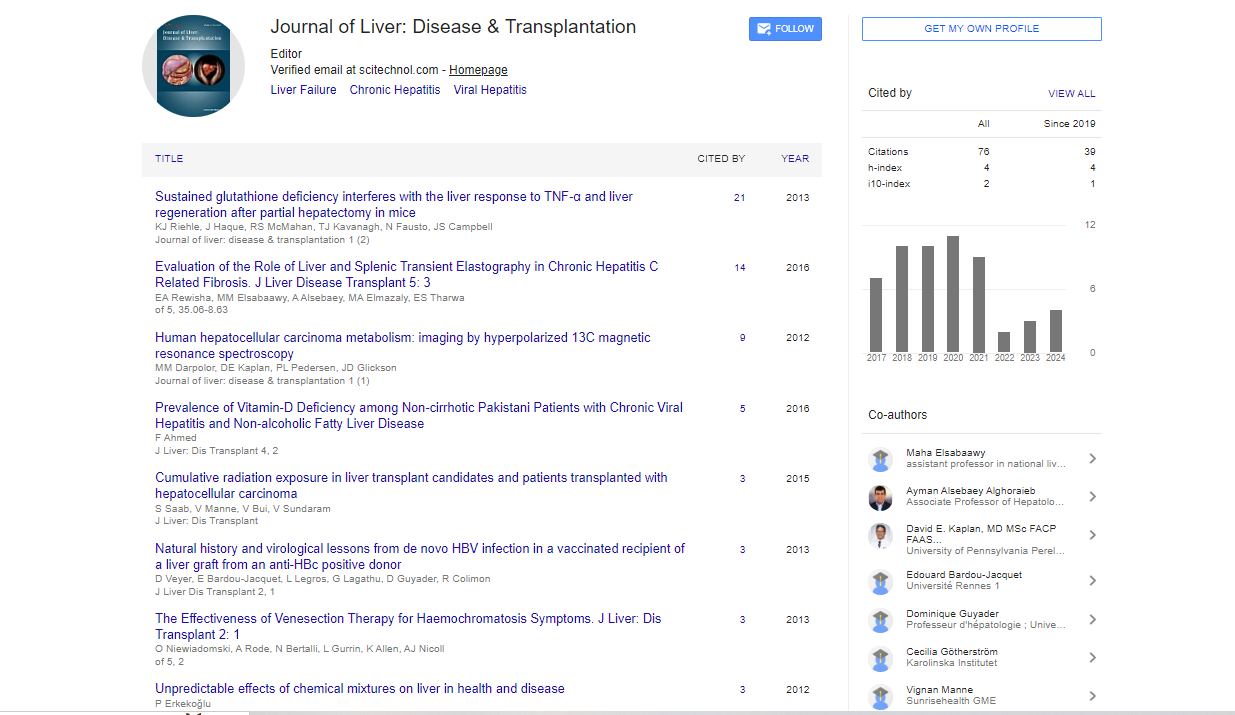Perspective, J Liver Disease Transplant Vol: 12 Issue: 4
The Complications of Wilson's Syndrome: A Comprehensive Study
Wooton Reik*
1Department of Internal Medicine, University of California Davis, California , United States of America
*Corresponding Author: Wooton Reik,
Department of Internal Medicine,
University of California Davis, California , United States of America
E-mail: reikwoo@ucdavis.edu
Received date: 20 November, 2023, Manuscript No. JLDT-23-123864;
Editor assigned date: 22 November, 2023, Pre QC No. JLDT-23-123864 (PQ);
Reviewed date: 06 December, 2023, QC No. JLDT-23-123864;
Revised date: 13 December, 2023, Manuscript No. JLDT-23-123864 (R);
Published date: 20 December, 2023, DOI: 10.36648/2325-9612.100249
Citation: Reik W (2023) The Complications of Wilson's Syndrome: A Comprehensive Study. J Liver Disease Transplant 12:4.
Description
Wilson's disease, an uncommon genetic disorder, intricately intertwines genetics, copper metabolism, and the liver's physiological intricacies. Named after Dr. Samuel Wilson, who first described it in 1912, this condition manifests as an abnormal copper buildup in the body, leading to a spectrum of symptoms and potential complications. Wilson's disease results from mutations in the ATP7B gene, located on chromosome 13. This gene provides instructions for producing a protein essential for copper transport and regulation. The mutated ATP7B gene disrupts the normal transport of copper within the body. Copper, a trace element vital for various physiological processes, accumulates in the liver and other organs. Liver-related symptoms are common, including hepatomegaly (enlarged liver), jaundice, and liver dysfunction. Cirrhosis, a late-stage complication, can occur if left untreated. Copper buildup in the brain can lead to neurological symptoms such as tremors, dystonia, and dysarthria. Psychiatric manifestations, including mood disorders and cognitive impairment, may also arise. Kayser-Fleischer rings, a characteristic copper deposition in the cornea, can be observed during eye examinations. Wilson's disease may affect blood cell production, leading to anemia and other hematological abnormalities.
Diagnostic approaches
Identifying mutations in the ATP7B gene through genetic testing is a definitive diagnostic method. Blood tests measuring serum ceruloplasmin levels and 24-hour urine copper excretion help assess copper metabolism. A liver biopsy may be performed to evaluate the degree of copper accumulation and assess liver damage. Imaging techniques, such as ultrasound and MRI, assist in visualizing liver abnormalities and assessing the extent of liver damage. The primary treatment involves the use of copper-chelating agents, such as penicillamine or trientine, which help remove excess copper from the body. Zinc, an essential trace element, inhibits copper absorption in the intestines and is used as maintenance therapy to prevent copper accumulation. In cases of advanced liver disease or failure, liver transplantation may be considered as a life-saving intervention.
The lifelong nature of treatment poses challenges in maintaining consistent adherence to medication regimens. Neurological symptoms may persist or progress despite treatment, necessitating ongoing management and support. The psychological and emotional toll of living with a chronic, potentially debilitating condition requires a holistic approach that includes mental health support. Families of individuals with Wilson's disease may benefit from genetic counseling to understand the risk of inheritance and make informed decisions about family planning. As Wilson's disease is an autosomal recessive disorder, siblings and offspring of affected individuals may undergo genetic testing for early detection and intervention. Ongoing study seeks to uncover additional genetic factors influencing Wilson's disease variability and presentation. Investigating novel therapies for managing and potentially reversing neurological complications remains a focus of study. Empowering individuals with knowledge about their condition enhances their ability to manage and cope with Wilson's disease. Joining support groups provides a platform for individuals with Wilson's disease and their families to share experiences and emotional support.
Conclusion
In conclusion, Wilson's disease stands as a testament to the intricate interplay between genetics, copper metabolism, and organ function. While advances in diagnosis and treatment have improved outcomes, the complex nature of the disorder necessitates a multidisciplinary approach. From genetic testing and chelation therapy to liver transplantation and ongoing neurological management, addressing the diverse manifestations of Wilson's disease requires a comprehensive and individualized strategy. As study continues to unravel the intricacies of this rare genetic disorder, the integration of innovative treatments and holistic support systems holds promise for a future where individuals with Wilson's disease can lead fulfilling lives despite the challenges posed by their condition.
 Spanish
Spanish  Chinese
Chinese  Russian
Russian  German
German  French
French  Japanese
Japanese  Portuguese
Portuguese  Hindi
Hindi 